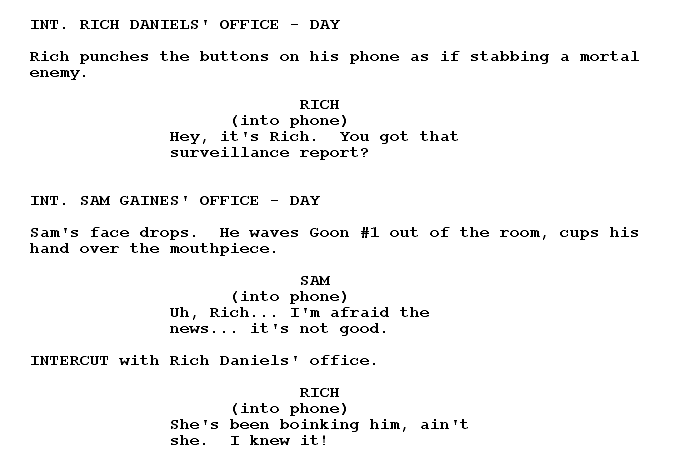

For more information: Recommended Links | Frequently Asked Questions
Copyright © 2018 by Michael Ray Brown. All rights reserved.
“First rate analysis at a cut-rate price.”
— Creative Screenwriting



Script Format: Telephone Calls
Telephone conversations can be tricky. There are various ways you can present them, depending on which character you wish to be the focus of our attention, and how much latitude you wish to give the editor. We can cut between both parties, or show just the caller or the recipient.


One option (and the most common way) is to establish the first setting with a brief scene, such as the caller dialing the phone, and then set up the second setting, such as the recipient picking up the phone. While still at the second setting, add the action element “INTERCUT with,” followed by the caller’s setting, all on the same line above the caller’s first speech in the scene. To clarify that a character is talking on the telephone, place the personal direction “(into phone)” under the cue:

On the other hand, you may not wish to show both sides of the call, but instead remain focused on just one character. In such scenes, it is rare these days in the cinema for us to hear the other party. Insert a parenthetical “beat” when the character we see onscreen is listening and reacting:

If it’s important that we hear both sides of the conversation, then the unseen character’s cue would have a “(V.O.)” extension and the personal direction “(over phone, filtered)”:

In this situation, the extension “(O.S.)” would be incorrect. “(O.S.)” is used when an unseen character is in the same setting, but just off-screen.
| Development Notes |
| Oral Consultation |
| Studio-style Coverage |
| Selling Synopsis |
| Proofreading |
| Sample Script Analysis |
| Sample Coverage |
| Sample Selling Synopsis |
| SolPix Interview |
| Creative Screenwriting Interview |
| Scriptwriter Interview #1 |
| Scriptwriter Interview #2 |
| Scriptwriter Interview #3 |
| Scriptwriter Interview #4 |
| Elements of a Great Script |
| Margin Settings |
| Scene Headings |
| Slug Lines |
| Description |
| Character Cues |
| Dialogue |
| Personal Direction |
| Transitions |
| Flashbacks |
| Montages |
| Telephone Calls |
| Registration |
| Software |